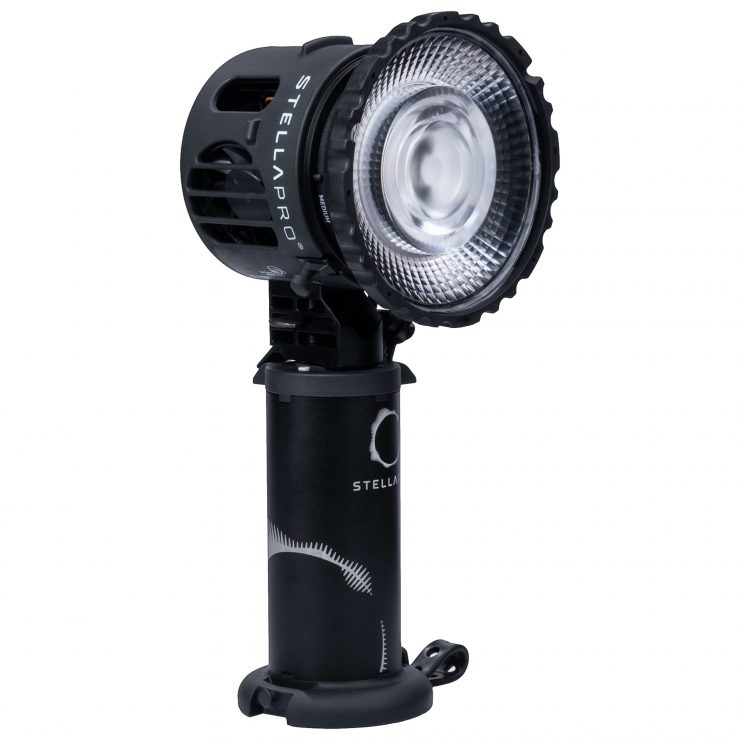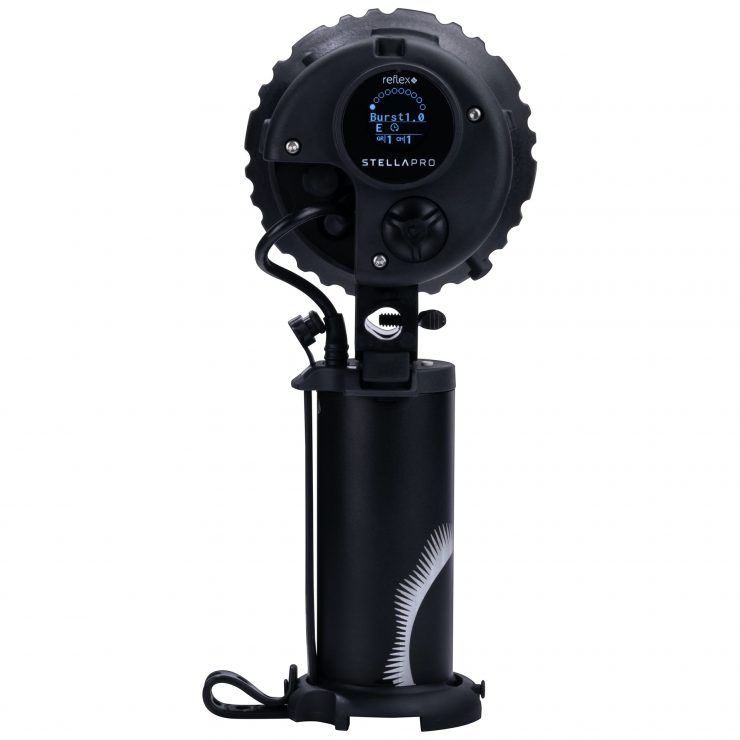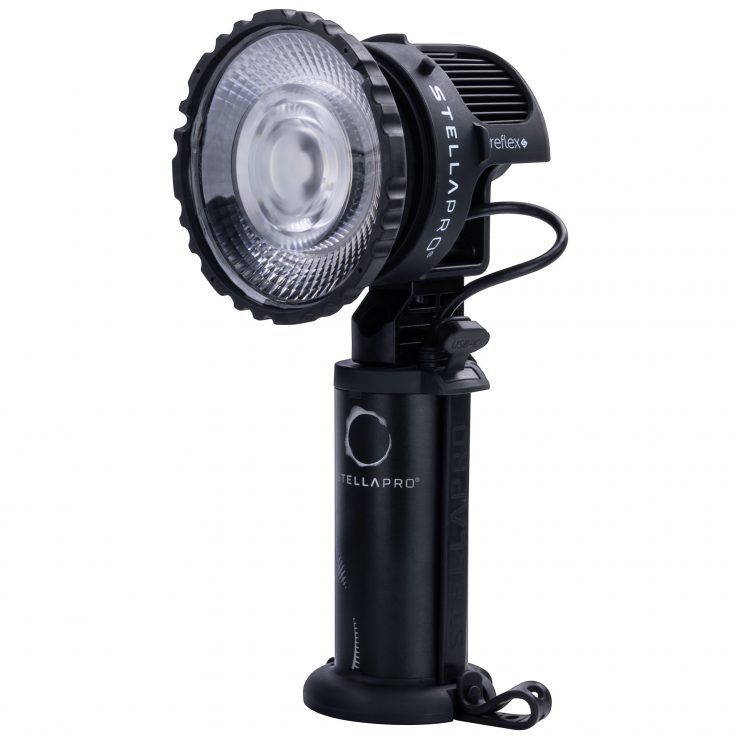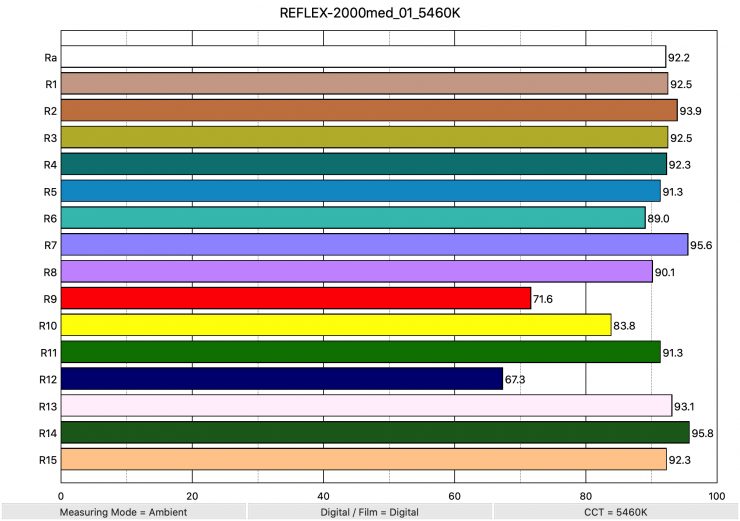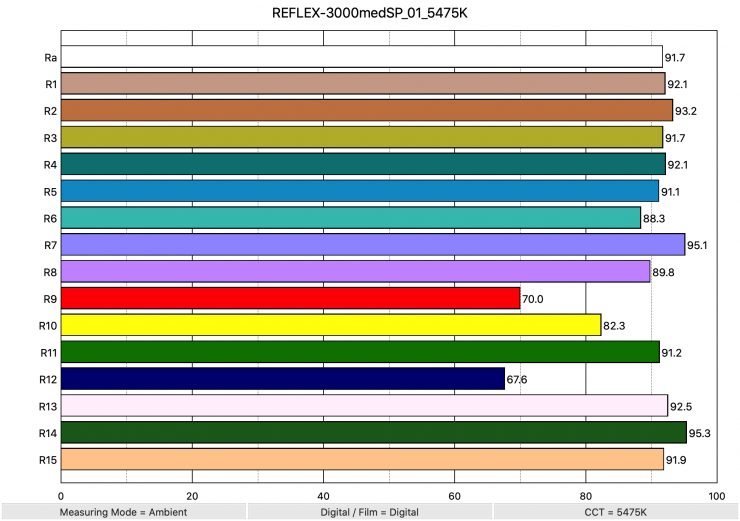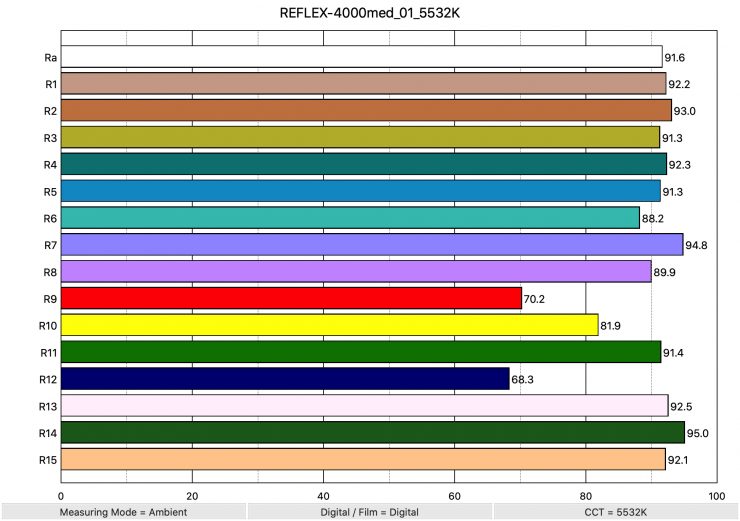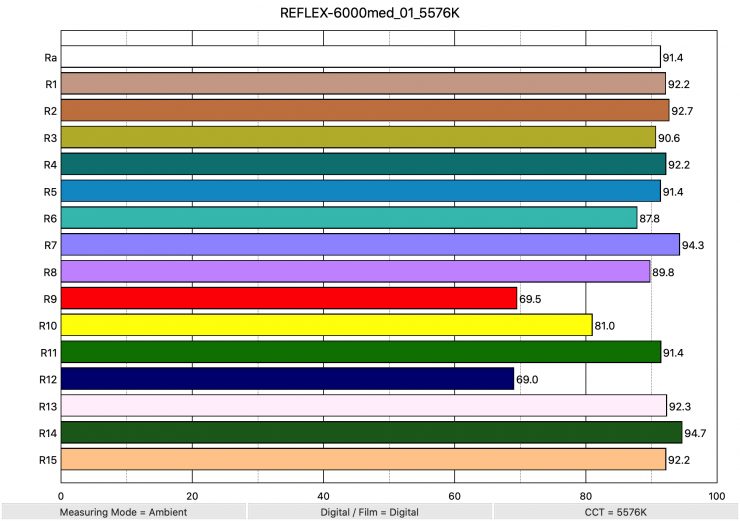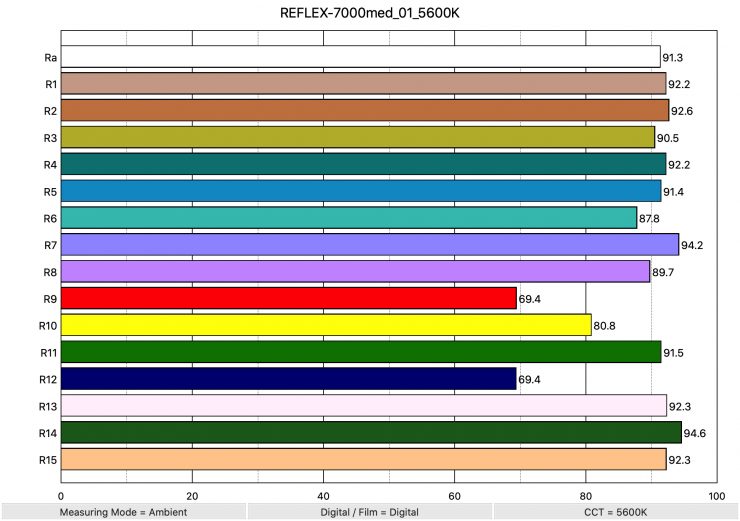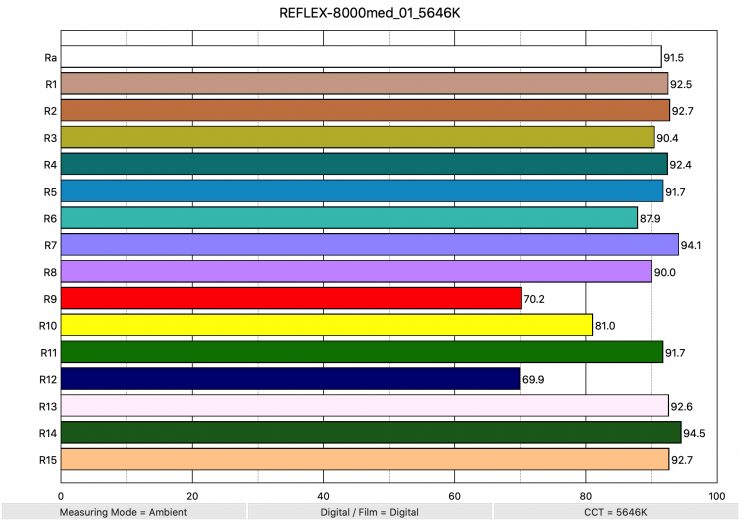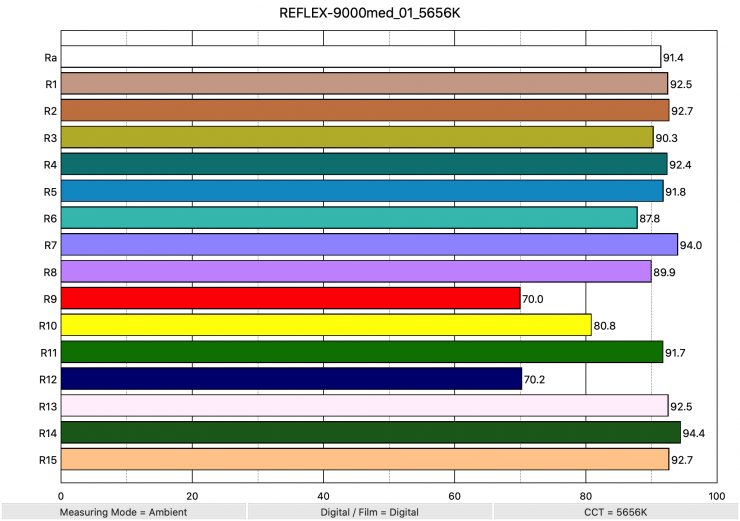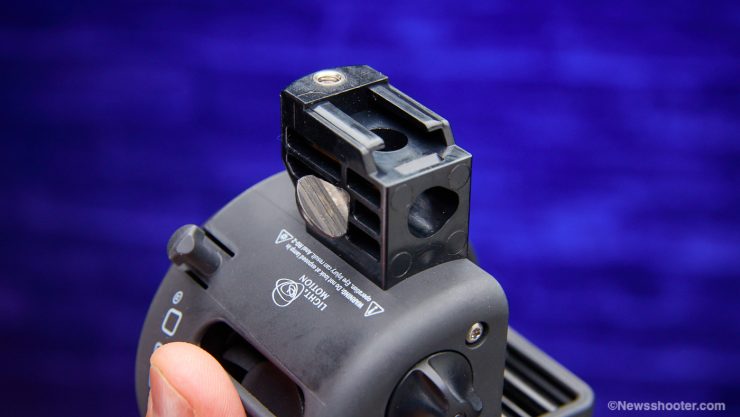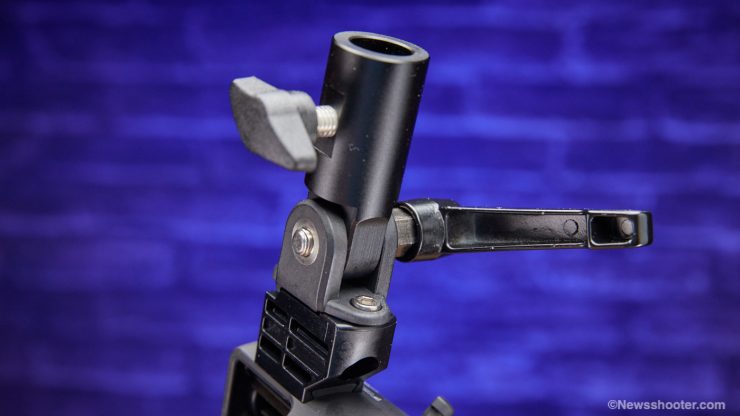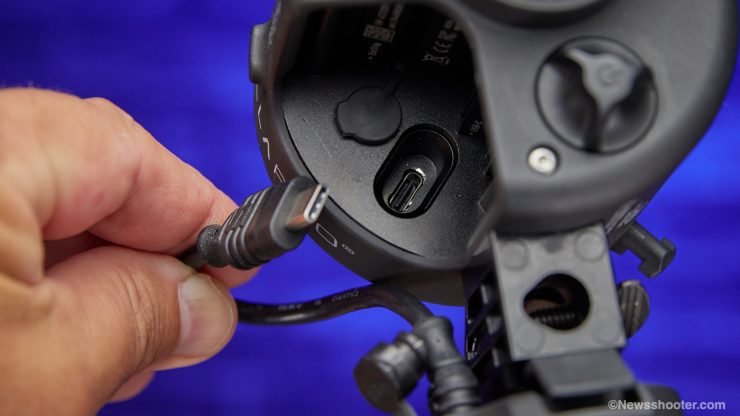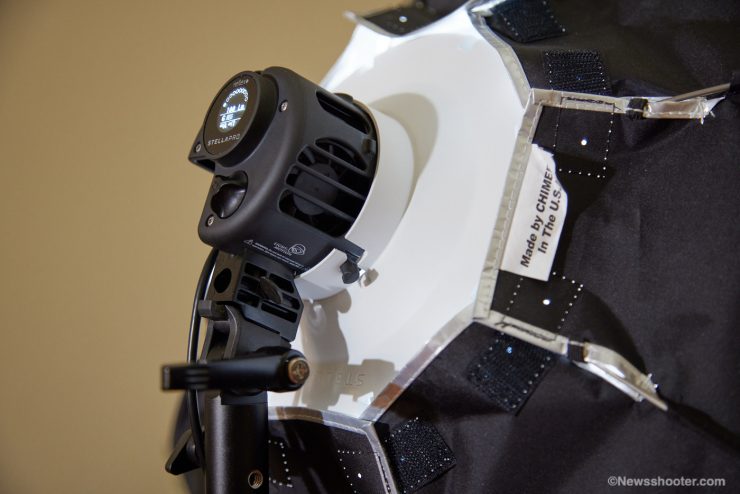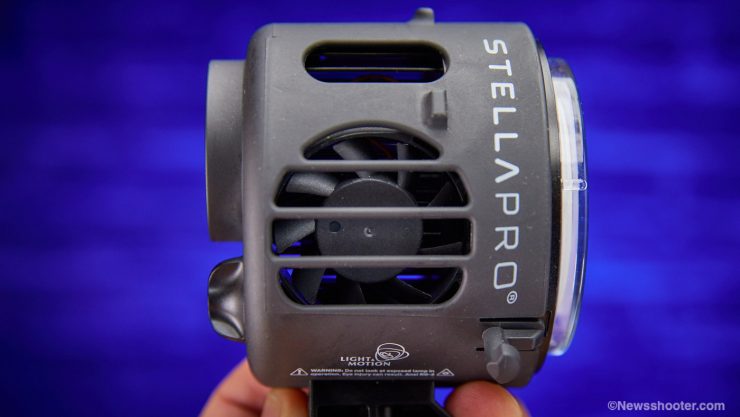
We have seen many lights come out in 2021, and trust me, it’s not over yet. But many have been relatively similar with mostly higher output. Not to say that isn’t a big deal, as high output LEDs are much needed.
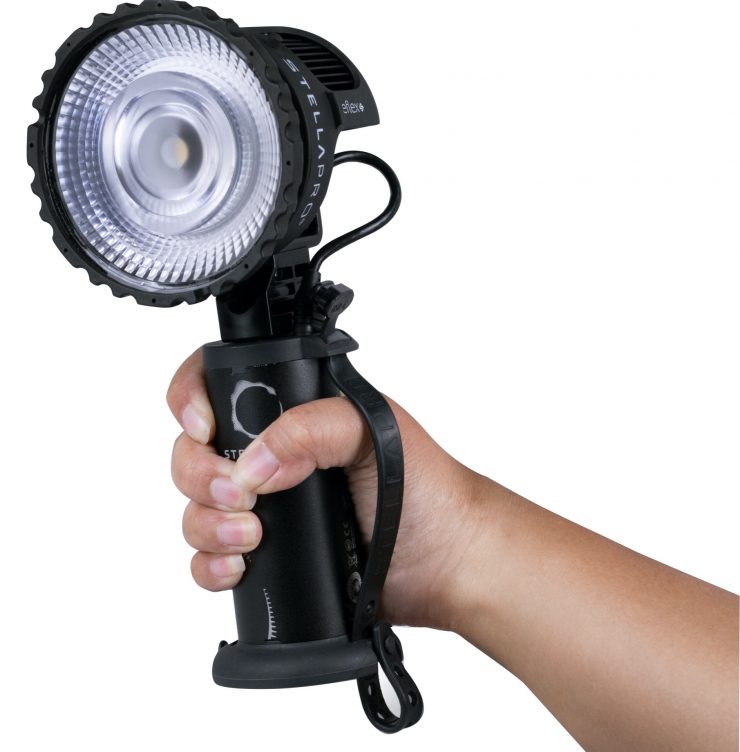
Today Light and Motion has released the 100-watt StellaPro Reflex and Reflex S. This fixture is doing something different. They combined a high output, very portable continuous light that also is a wireless flash capable of high frame rate shooting. Add in an optional 60-watt battery handle, and this combo is sure to get hybrid shooters excited if they need both.
Wedding and event shooters are high on the list as professionals who would appreciate such a design since it’s very portable and will travel well. It’s always great when gear like lights can perform two things, so you don’t have to double up, but can one light do both well?
Is Reflex the First?
The Reflex isn’t the first light to offer dual use. The Rotolight AEOS and NEO 2, for example, have the option for continuous and strobe; however, they require the use of a Rotolight Elinchrom EL-Skyport Transmitter Plus that retails for $250 USD. In comparison, the Reflex can use much cheaper 3rd party offerings like a Godex that retails for $69 USD.
Rotolight has announced the AEOS 2 and NEO 3 that feature a built-in Elinchrom receiver, but they are not available yet.
Godox and Profoto also have offerings. The Godex FV200 retails for $450 USD and the FV150 for $349 USD. The Profoto B1X 500 AirTTL 1-Light To-Go Kit costs $2,590 USD. I haven’t used either of these options before, so I can’t judge them.
Kelvin
The Kelvin color temperature of the Reflex is 5600K. I tested several output settings to see if it retains the Kelvin temperature throughout the range. I found it did fairly well and was closer to the 5600K at higher outputs.
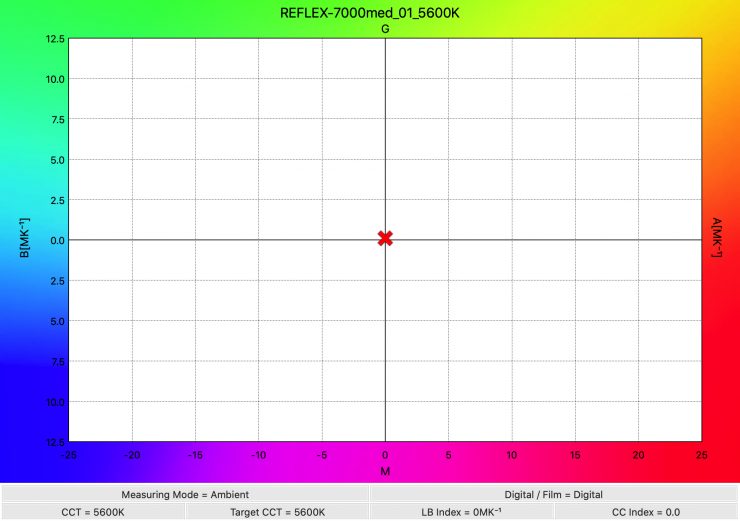
At 7000 lumens output setting the Stella hits 5600k.
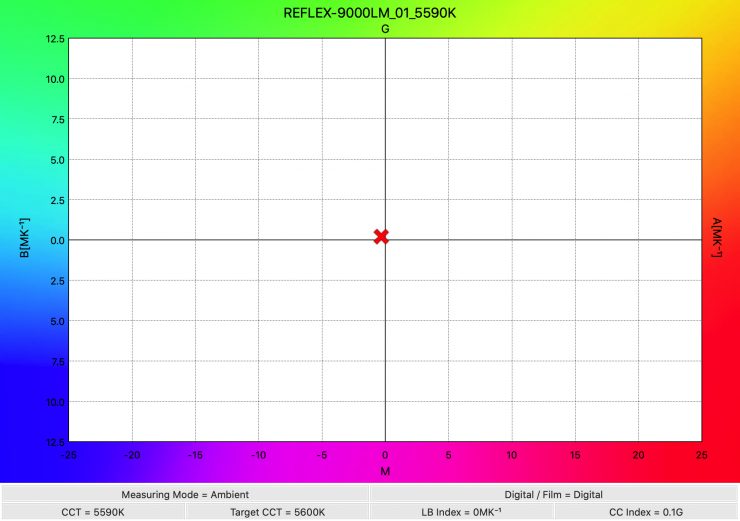
At 9000 Lumens setting, I metered the Reflex at 5590K.
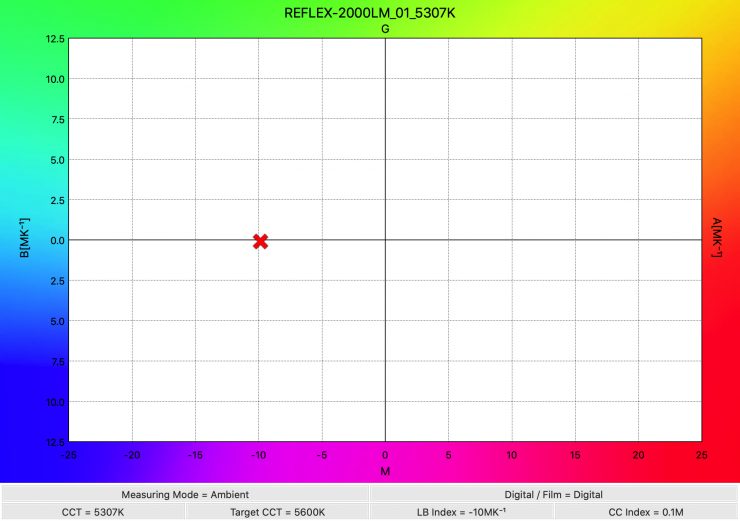
Interestingly when set lower to 2000 Lumens the Kelvin drops to 5307K. As you bring the brightness up the color temperature improves. Another interesting result is the Medium Lens adds approximately 100K to the kelvin to all the output settings. Not a large enough factor to correct when using the lens.
Color
Modern LED fixtures have improved a lot but it’s important to know if a fixture is color accurate so let’s do some testing.
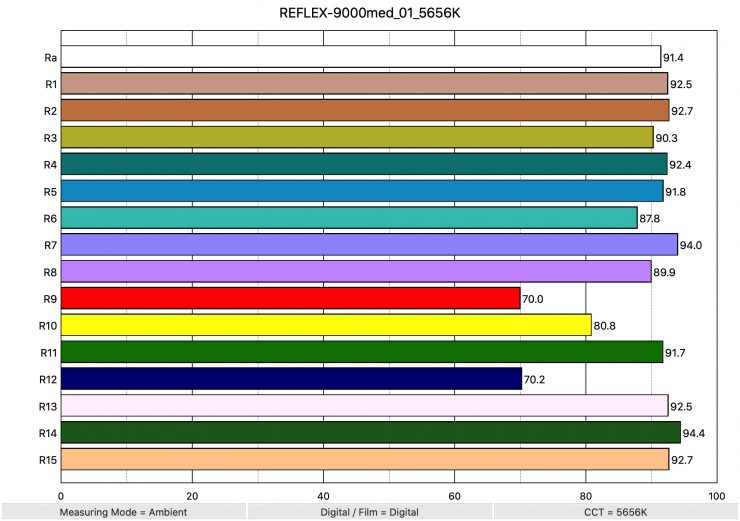
Let’s start with the full output of the Reflex and see how it performs. The test graph shows good scores with an average CRI of 91.4 and an extended CRI of 88.24. The score took a few hits from the R9 Red at 70 and R12 deep blu, scoring low at 70.2. Is this bad? Well not exactly as the more important R15 for skin tone scored very well at 92.7. In practice, the color will look good.
Similar to the kelvin tests the color does change a bit when the light is at a lower output, but for the most part it’s not an issue as it’s so slight you won’t be able to see a change. Below are all the readings from several output settings.
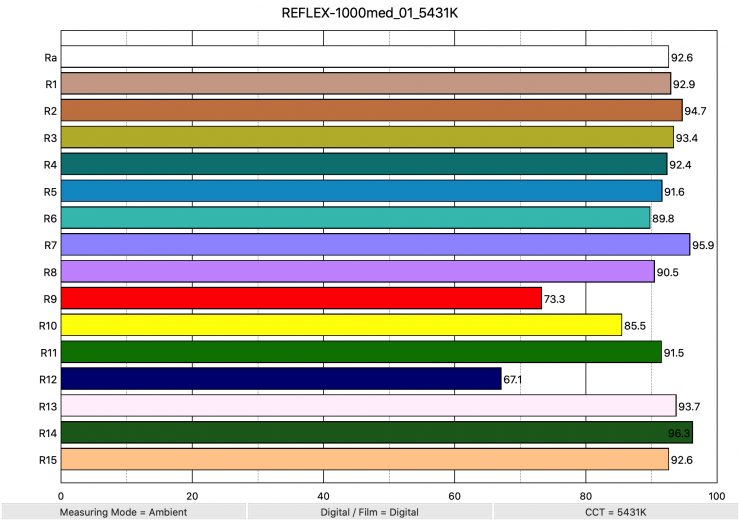
Also worth noting is the kelvin temperature is listed in the bottom right corner of each chart.
Output
The Reflex uses lumens settings for output as opposed to 1-100% scale. I set the light with the clear COB cover 1 meter away from the Sekonic C-700-U Spectromaster and took several readings with multiple output settings. I chose to use the bare COB for color accuracy since modifiers can change the color of the output. Yes, it would be rare to use the light in this way, but if you want to flood light in an area to get the overall brightness up bouncing into the corner or ceiling works great.
LUX output with Sekonic C-700-U Spectromaster from 1-Meter (3.28 feet)
- 2000 Lumens – 508 Lux
- 4000 Lumens – 1410 Lux
- 6000 Lumens – 2190 Lux
- 7000 Lumens – 2570 Lux
- 8000 Lumens – 2860 Lux
- 9000 Lumens – 3110 Lux
Keep in mind this uncorked COB is in extreme flood mode without a modifier added.
Output with included Medium Lens
The StellaPro Reflex comes with a Medium 24° Lens that focuses the light quite a bit. I ran the same type of test from 1-meter with the Medium 24° Lens attached. To get an idea of the spread I took two readings. One from the center and another 12″ from the center and got the following.
- With the light set to 3000 Lumens, the center was 10,900 Lux,
- 1-foot from the center, it was 3180 Lux.
I know at 1-meter or 3-feet seems very drastic, but it shows the lens does what it’s supposed to do. At further distances, it gives a nice balance of spread and control. Hop over to modifier options to see what’s available. The wide 50° Optic is nice as well as the soft dome diffuser.
One thing to keep in mind is the lens isn’t a Frenel. It’s designed to control the beam width, but not make the light’s edges sharper.
Build Quality
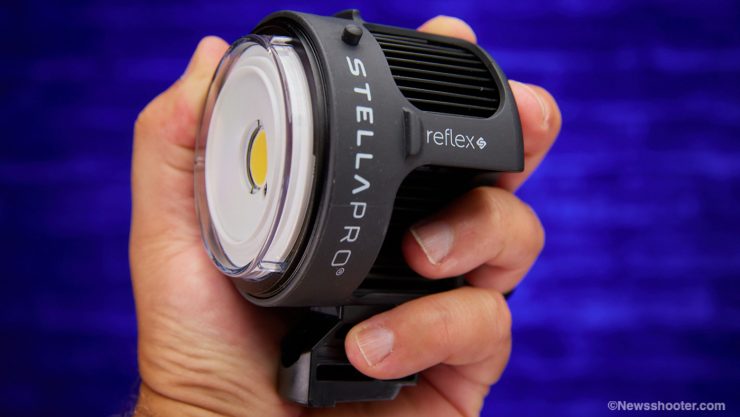
To say the Reflex is small is an understatement. The fixture fits in the palm of my hand. All it needs is the USB-C cable and power adapter to power it. On the bottom is a cold shoe receiver similar to what you see on a camera. With a simple turnaround to a male cold shoe, you can mount the light in several different ways.
The fixture has a lot of plastic parts. This isn’t a bad thing as it keeps the weight down. The cold shoe mount on both the fixture as well as the battery is also plastic. The lamp head slides into the battery handle and clicks in. It is secure with no wobble. There are no tilt options in between the light and the battery. To have this ability, you can either take the battery off and add a light stand receiver with a cold shoe mount on the fixture or add it to the bottom of the battery. I would say the build quality is very good and feels like a quality product.
Mounting Options
The Reflex can be mounted to a Battery Handle or directly to a light stand adapter that is an optional product.
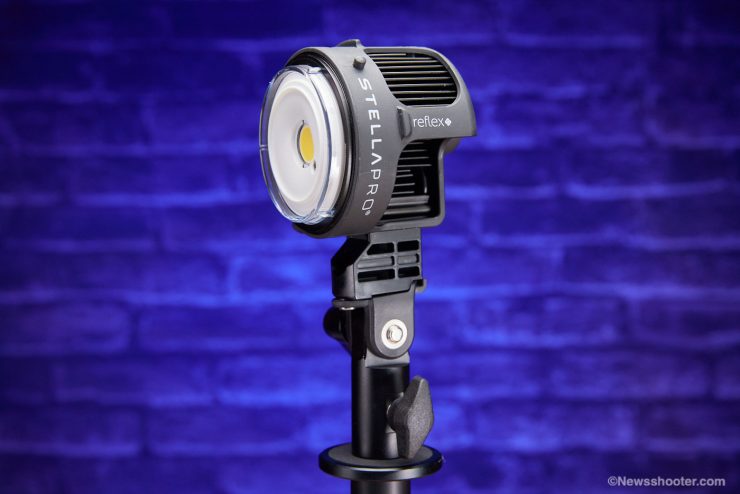
On the bottom is a reverse cold shoe that the light stand adapter slides into. It locks into place with a hex screw. This design is the same as the Battery Handle. When using the battery Handle, the light stand adapter then attaches to the bottom of the Battery Handle.
Powering Options
The Reflex has a 60-watt battery option with the sold-separately Reflex Battery Handle. You can use it with AC as well.
It can also be powered from any USB-C power source that is rated at 100W. Reflex max continuous output is 9000 lumens when used with a 100W power source.
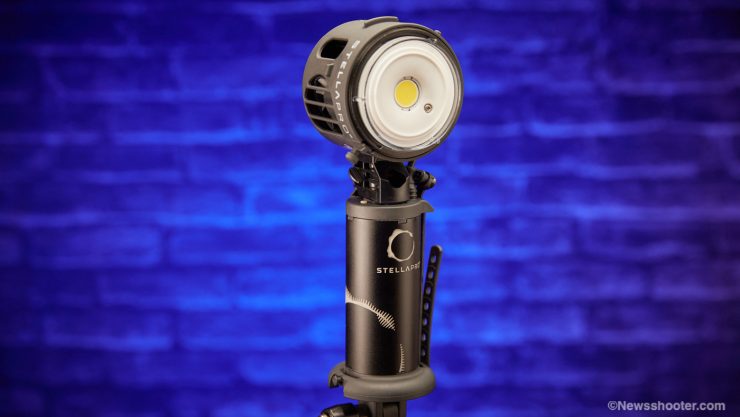
Reflex Battery Handle 60W Continuous: 100-6000 lumens
100W External USB-C Power-Continuous: 100-9000 lumens
As you can see, when used with the 100-watt charger, the Reflex outputs 3000 more lumens. This is a substantial amount and should be considered if the battery option is important to you.
Reflex Battery Handle
The Reflex Quick Switch Battery handle acts as a grip for the lamp head. It attaches to the Reflex using a cold shoe type connection. The 60W battery is a high-capacity rechargeable 38 Whr Lithium ION. The Battery Handle doesn’t include a PD charger. It does include a longer 2′ USB-C cable that fits nice and tight in both the light and battery.
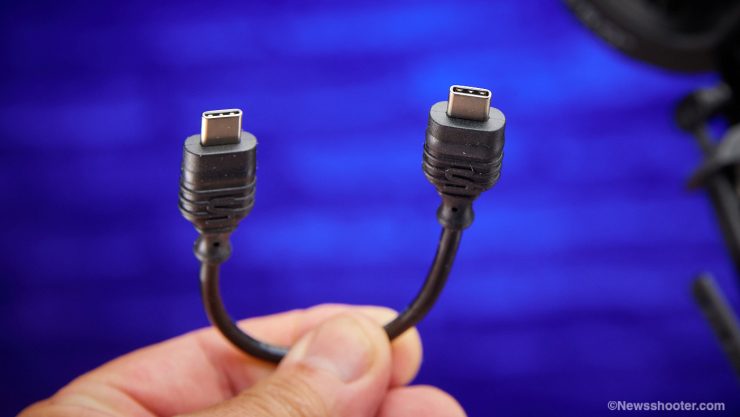
Something worth mentioning is the USB-C cable connectors are designed to be form fitting on both. The supplied cable fits very snug and is designed to do so as it keeps them much more secure than using a generic cable. With that said you can use a different cable but won’t have the benefit of that tight fit. I think some kind of lock would have been a good idea for more compatibility. I don’t know how much the cables cost direct from Light and Motion.
Battery Runtime
The charging time for a fully drained battery is approximately 4 hours. A full charge will provide 15,000 full power Digital Bursts.
Continuous
Full power (30 minutes)
Low Power (600 minutes)
Powering With AC
When powering with AC things are a little different than you may be used to and this will make more sense when you factor in the size of the Reflex fixture itself.
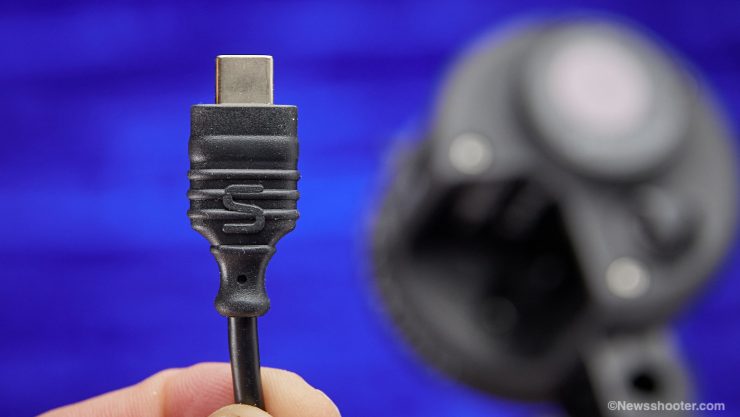
Since the main powering interface is a USB-C connector you will need to use a 100-watt USB-C PD charger to feed enough power to the light in order to get full output. These bricks are smaller than the average AC ballast but designed to be inserted into a wall socket, therefore you need to find a way to mount it on a stand and run the longer USB-C cable that is included. Light an Motion offers a long 9.8′ cable with form-fitting ends.
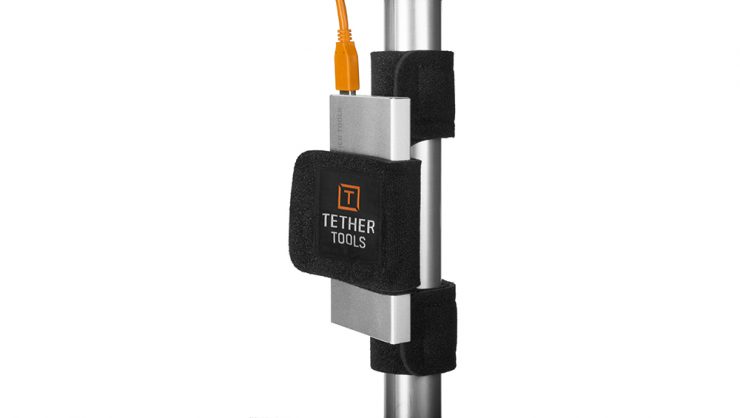
I found an easy way to do this with a Teather StrapMoore neoprene mount. This thing has worked for me in so many similar situations with AC power bricks.
It’s different but in practice works the same as a conventional AC brick. You will need the charger anyways if you go with the Battery Grip option. The 100-watt charger isn’t included with either the Reflex or Battery Handle. The 100-watt versions cost around $30 to $50 US.
Modifiers
The StellaPro Reflex is designed to use modifiers as the front is a bare COB LED. Without anything attached it’s bright and very wide. Instead of using hood reflectors, the Reflex uses lenses. It ships with a Medium 24° Spot Optic lens. These lenses are not considered a fresnel type as they don’t generate sharp edges. They are designed to focus/spread the light.
Lenses
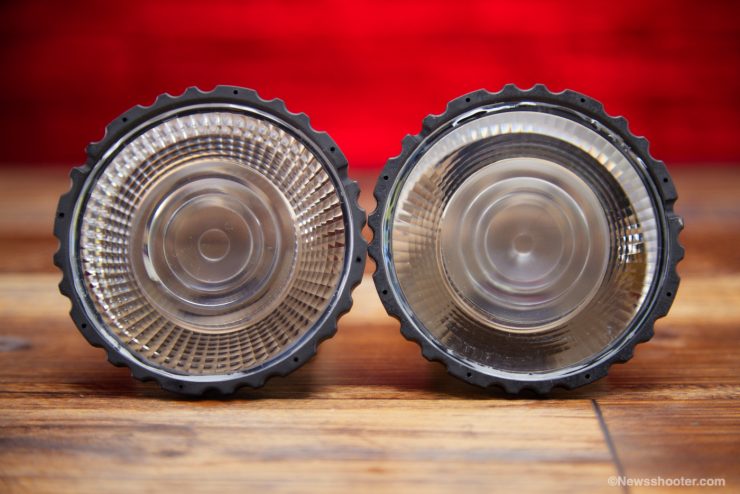

Medium and Spot Lenses 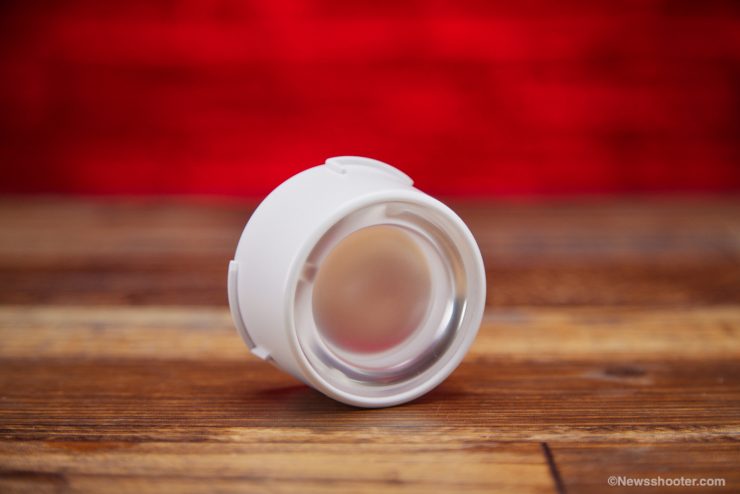
50-Degree lens 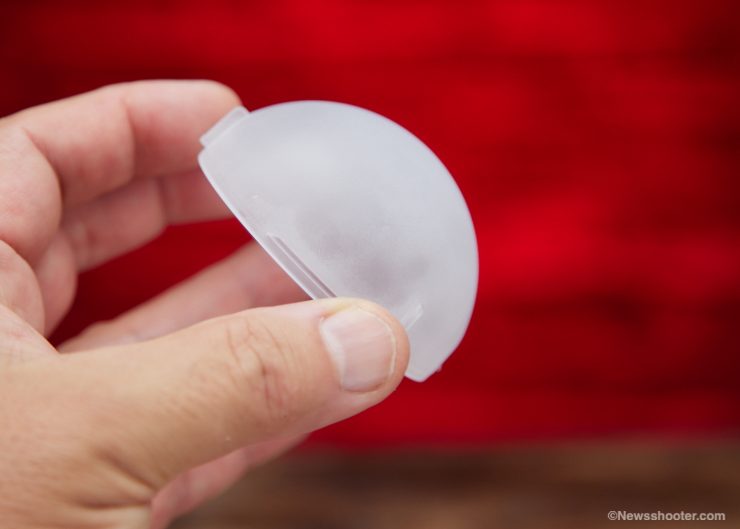
Dome Diffuser 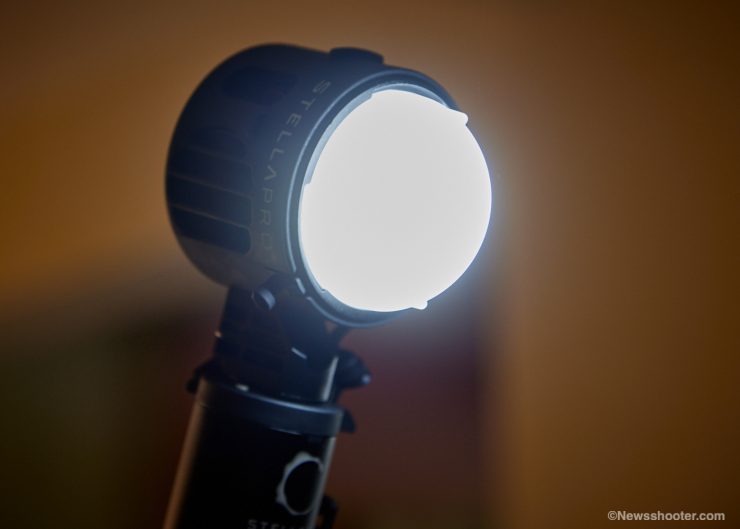
Dome Diffuser On Reflex
- Medium 24° Spot Optic
- 50° Lens Optic
- 12° Spot Optic
- Dome Diffuser
To get an idea of the spread with modifiers, I set the Reflex at 2000 Lumens and positioned the light 5′ 10″ or 1.77 meters from the flowers.
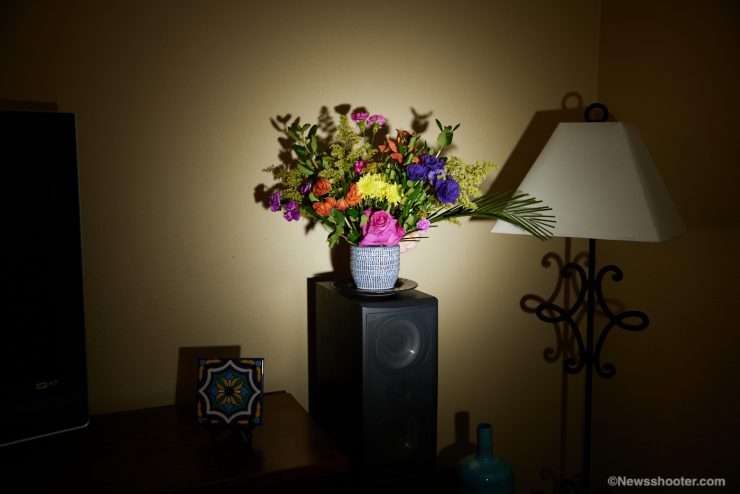

Spot Lens 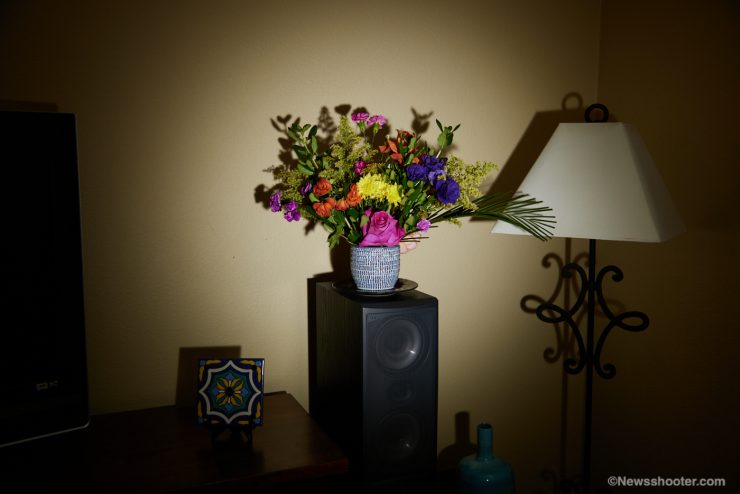
Medium Lens 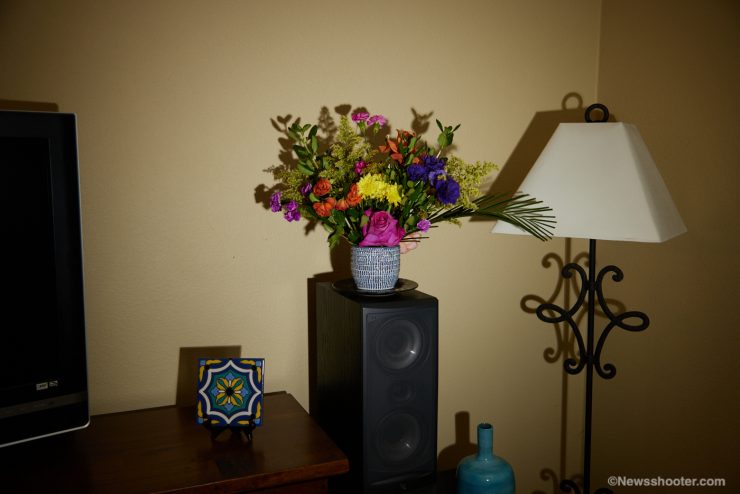
50-Degree lens 
Dome Diffuser 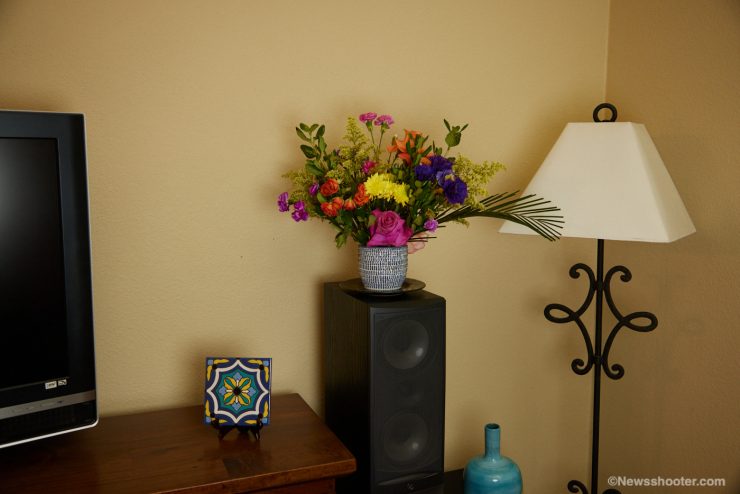
Chimera Softbox
My personal favorite of the four lenses is the Dome Diffuser. This isn’t a surprise since I love soft light. I also like the Chimera softbox as it does a great job diffusing the light and eliminating harsh shadows.
A takeaway is how well the lenses perform. You don’t need barn doors as the spill is controlled well with the optic. Especially the spot and medium. These are great for back and hair or when you need a little pop.
Chimera Octa Beauty Dish and Speed Ring
The sample came with a Chimera speed ring (69.99) that twists and locks in place. It’s made of plastic and is very light. Here is where plastic delivers the best performance. It’s plenty rigid and very light.
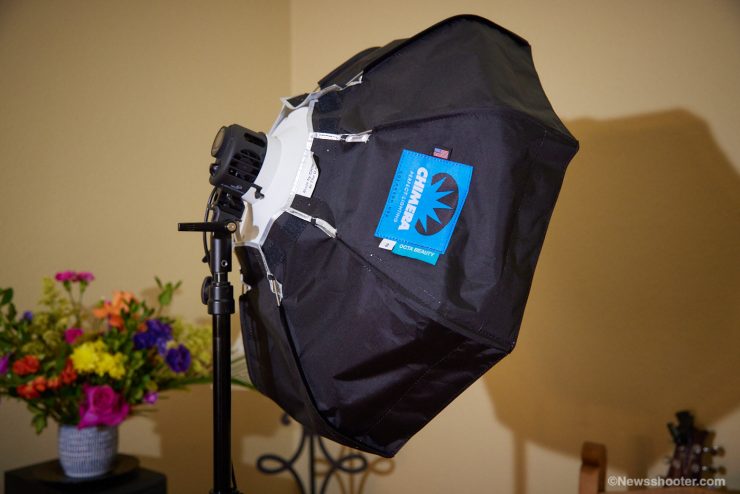
The Chimera Octa Beauty Dish ($248.99) isn’t very deep but it has an extra layer of diffusion mid-way inside the softbox. This helps prevent a hotspot and does a good job spreading the light on the front of the diffusion. You can add a lens to the Reflex when using the Chimera Softbox if you want to little more punch in the center. The Soft Dome can be added to make the output even softer. Lots of options and I like that.

The self-portrait was with the Chimera on the left with the Reflex set at 2000 Lumens and the other had the Dome Defuser set at 400 for a little fill. I like it, well the model needed an upgrade but this guy works for free!

The next sample above from the same handsome model is the same Chimera setup but with the other Reflex as a backlight using the spot lens. A little more dramatic. I know these are not the best examples but I think you get the idea.
The light looks nice and soft with the Chimera softbox. Being shallow keeps with the design idea of being compact. Also, the Reflex isn’t a big heavy fixture so physics will kick in and make it somewhat unstable if large long softboxes are attached.
Keeping it Cool
With such a compact head the Reflex doesn’t have a lot of room for a large fan to keep it cool when in continuous mode.
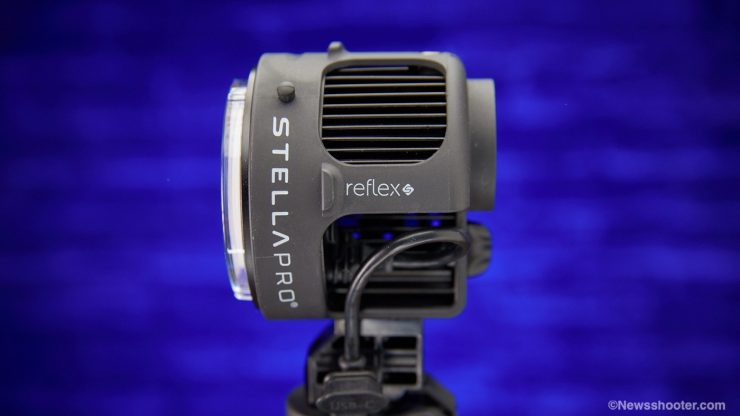
The circular head is surrounded by metal heat dispersing fins. On the side is what appears to be a 1.5″ fan that pulls heat out of the fixture. The fan only kicks on when the Reflex is set over 4000 Lumens and stays on. If you drop the output the fan shuts off. It has two speeds. Low Speed kicks in at 4100-6000, and High Speed at 6100-9000.
As for how loud it is? It’s not silent and It could be an issue in quiet environments when you need that extra punch. This might not be an issue if you keep the Reflex et to 4000 Lumens and at that settings it’s bright.
I get a better idea of just how loud the fan is I tested the level with a Decibel meter and here are the results
Fan Noise
Fan noise is not a new thing for Light and Motion fixtures. Matt reviewed the CLx10 and found it to be louder than he liked. The Reflex also has a bit of a fan noise issue as well. It does take on the form factor of Light and Motion fixtures.
To see if I could use the Reflex without the fan kicking in I set up the Reflex approximately five feet from me in a low lite area and was able to use the light at 4000 Lumens setting with an F4 aperture at 500 ISO with a C200. This is borderline depending on the camera’s sensitivity, however, ISO 500 is low and I could easily go to ISO 850 and bring down the Reflex output more. The challenge will be to set up the light close enough to the subject and keep the light no brighter than 4000 Lumens to avoid the fan noise.
Depending on how much ambient sound is in the area you are shooting an interview or sound will make a difference. The fan has a higher pitch so it can bleed into the audio if the light is closer than 5 feet away from the mic.
Usability as a Flash
I’m not a professional photographer by any means and flash photography is something I don’t do. Heck, I don’t even own a flash unit. With that, I will test the flash capabilities to the best of my abilities,s but I know the value of having both options in one fixture as a flash option is very cool for those who do both video and stills.
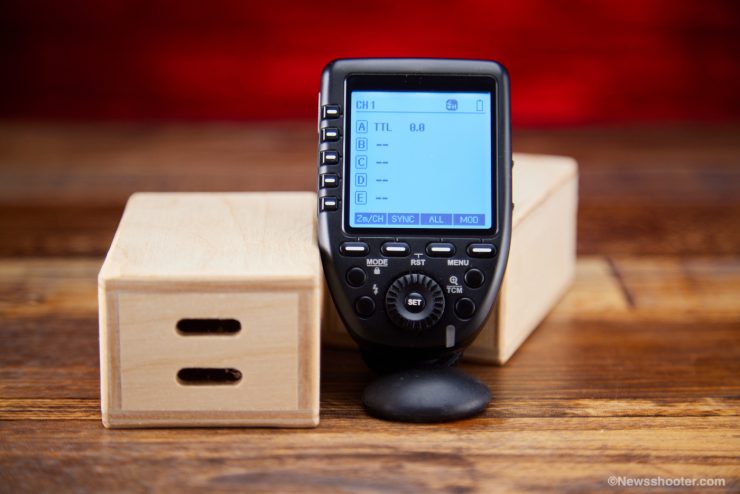
The Reflex can use a few different flash triggers. The one Light and Motion supplied for the review is an inexpensive $69 Godox XProC TTL Wireless Flash Trigger for Canon cameras.
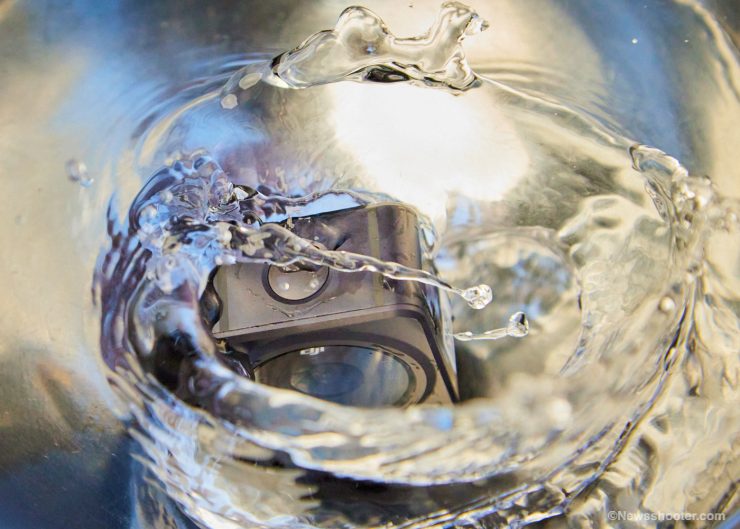
I shot the DJI Action 2 hitting the water with the Reflex and a Chimera box with the Canon R5 set for high-speed continuous shutter release and did a gazillion shots to get the camera to fall just right. It didn’t but this shot looks pretty darn cool! The Reflex S flash mode kept up without issue making every frame a technical keeper.
With the battery, Reflex can produce 15,000 full-power, 5 milliseconds (ms) bursts on a single charge with the battery.
- Battery handle/100w power source
- Burst: Lux@1m w/ Spot Optic : 86,000 lux
- Digital Burst power is 1⁄2 stop more light when powered off 100W AC
- 12000/18000 lumens
- Maintains full power at sync speeds over 1/250th sec
- 15,000 full power bursts from a single battery charge
While using the Reflex as a basic flash is great its ability to perform at a high burst speed is impressive. I’ve said it before and I’ll say it again having one light that does both flash and continues ticks a lot of boxes for event and wedding photographers that need to shoot both stills and video. The Reflex S in Burst mode is capable of 20 fps. while the Reflex does 10 fps. If you are mainly a video shooter and don’t need the higher burst rates the Reflex will save you some cash.
Final Thoughts
The Reflex is a light that wants to do two things well. It’s not easy to do. Being a flash and continuous light means it has to have a lot of punch and the Reflex does plus it’s so small.
Powering with USB-C is something I have to get used to as it’s the only fixture I have used that depends on it as the main source. This requires a 100-watt PD-type charger that is used with a lot of consumer devices. I’m used to AC cables and secure robust connectors but I understand why the StellaPro Reflex can’t have them as it’s too small and would be just like other fixtures. My main concern is how durable the USB-C cable and charger combo will be on set and with daily use.
These chargers are designed for a wall socket and using a 3rd party USB-C power cable won’t give you that solid connection like the included form-fitting one. These cables are designed for computers and not for the main power cable like traditional ones.
If you are a hybrid shooter and want to keep your lighting kit small and light, the Light and Motion StellaPro Reflex is a light you should consider. I like the idea of a very capable high-speed flash and continuous light combo. The dang thing is even water resistant!
Pricing and Availablity
The StellaPro Reflex retails for $849 US and Reflex S for $1,096 US are available for purchase now.

